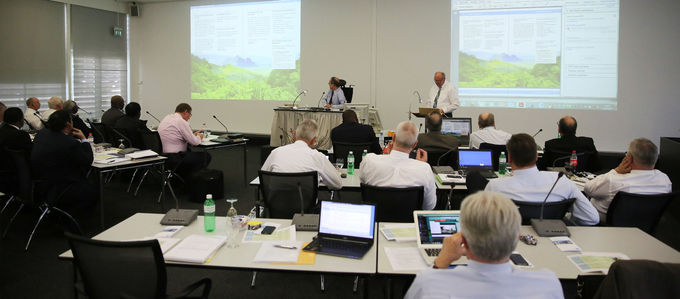"Questions and Answers" will be published in fall 2015
A new variant of the Catechism of the New Apostolic Church is scheduled to appear in September 2015. This resolution was passed by the District Apostle Meeting at its most recent session. The reference work has been structured into "Questions and Answers" and is scheduled for publication in five languages to start.
"Work on the new variant of the Catechism is right on target," explained the responsible designate, District Apostle Bernd Koberstein, during the District Apostle Meeting on 13 March 2015 in Zurich, Switzerland. Translations into five main languages have been completed, along with the layout. Now it is just a matter of taking of the finishing touches to prepare for printing.
Common start in several languages
Actually, the "Catechism in Questions and Answers" (CNAC QA) could just as easily have been published successively in English, German, French, Spanish, and Portuguese, however the District Apostle Meeting resolved that the various language versions should all be published on the same date. This will also mark the starting shot for further editions where the translation is already complete. First and foremost, these include a series of regional languages in the Democratic Republic of Congo, which is home to approximately one third of all Church members in the world.
Soon after the publication of the Catechism in the year 2012in the Church's main languages, many other translations followed. In addition to the printed edition, the Catechism was also made availablein various e-book formats. Beyond that, other versions were made available for the internet. Right in keeping with the times, a Catechism App was also developed for smartphones and tablets, as well asfor iOS and Android.
For use as instructional material
Beyond that, however, it was important to the Church's leadership to develop a version of the CNAC that was expressly suited to teaching purposes. For this reason, the text of the Catechism was divided up into 750 questions and answers. So explained the Project Group "The New Apostolic Faith" (PG TNAF), who has been working on this reference text for nearly ten years.
The question-and-answer format has been in use for centuries in in Christian catechisms, and also has a long tradition in the New Apostolic Church. The didactic methodology behind this is tested and tried. Thus the CNAC QA is soon to be employed for the instruction of ministers, and serve as an accompanying text for the instruction of children and young people.
Focus on comprehensibility
The new version of the Catechism aims to provide greater understandability and reader friendliness. To this end, the reference text employs various tactics:
- By way of questions and answers that build upon one another, readers are taken by the hand, so to speak, and led through the content.
- The various topics have been structured into a large number of individual questions and answers in order to keep trains of thought as brief as possible.
- The text is formulated in a manner that is as easy to understand as possible, without using many technical terms.
- Terms that cannot be understood on their own are explained in detail when they first appear.
- The text contains many complete Bible quotations. This allows readers to work with the book even if they do not have access to a Bible.
Constantly occupying oneself with doctrinal content
"A church that forgets its doctrine is a weak church"—it was with this quotation from Chief Apostle Jean-Luc Schneider that the PG TNAF made it clear how important it is for all New Apostolic Christians to know their doctrine. During the divine service in Toulouse, from which this quote was taken, the Chief Apostle appealed to the members to make the effort to become acquainted with the doctrine of the New Apostolic Church.
For example, nacworld.net, the social network of the New Apostolic Church,is offering some help with this effort: all nacworld content directly links key terms from the Catechism—be it in official articles or private contributions—to the respective passages in the CNAC. This means that in all conversations and exchanges, the Catechism is only a click away.
Article info
Author:
Date:
Keywords:
Andreas Rother
16.03.2015
Catechism
, Switzerland,
District Apostle Meeting (DAMI),
Media,
International




























